M1940 carbine - a rarity from Smith & Wesson
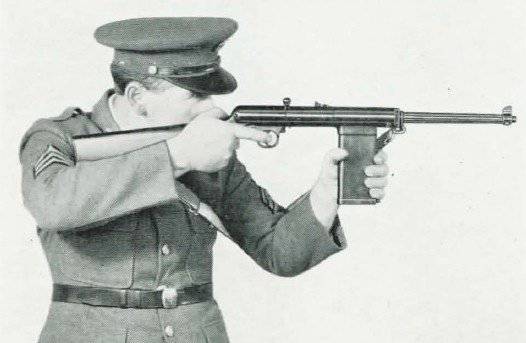 Model 1940 9mm Light Rifle is undoubtedly the rarest weapons, which was mass-produced by Smith & Wesson.
Model 1940 9mm Light Rifle is undoubtedly the rarest weapons, which was mass-produced by Smith & Wesson.Many collectors, fans of the S & W brand, could not get this item in their collection, and many gun lovers did not even hear of it.
History create
The American self-loading carbine Smith and Wesson of the 1940 model (Smith & Wesson Semi-Automatic Light Rifle Model 1940), contrary to the name, is not a rifle, but a carbine chambered for a pistol cartridge. In all likelihood, development began in 1939, and the weapon was intended to arm police units. The work was carried out by a team under the general direction of Joseph Norman, head of research and development at Smith & Wesson. Since the model was introduced in 1940, it is also called the Smith & Wesson Semi-Automatic Light Rifle Caliber 9 MM Model of 1940, or in short: M1940.
Conscription
After a series of tests of the self-loading carbine by the US Artillery and Technical Service for its adoption by the US Army, positive reviews were received for it, but experts recommended remaking the carbine for a standard cartridge for the US Army, that is, chambered for .45 ACP cartridges. However, Smith & Wesson was already loaded with military orders, and therefore the S&W M1940 carbine continued to be produced under the 9x19 Parabellum cartridge.
Fraternal help
After the disaster at Dunkirk in 1940, an emergency evacuation followed (Operation Dynamo). During this evacuation, only the British lost weapons, equipment and equipment for the 9th divisions of the British Expeditionary Force. As a result, many soldiers patrolled the coast, armed with nothing but single-action Colt Peacemaker M1873 revolvers, and England asked American hunters and athletes to donate their rifles to defend foggy Albion. But these were half measures: it was necessary to urgently compensate for their losses. As a result, Smith & Wesson was awarded a contract to supply a huge number of Military & Police revolvers chambered for .380-200.
Most likely, during negotiations related to the purchase of revolvers, the British learned about a prototype of a promising carbine, and in the hope of partially solving their problem, ordered a batch of S&W М1940 carbines in the amount of 1940 pcs. We came to an agreement, signed a contract, patted each other on the back. The contract value was US $ 1 million.
Lend-lease or not?
Many are convinced that the delivery of Smith & Wesson Light Rifle carbines was carried out under a lend-lease agreement, but I believe that this is not the case:
The United States Protection Enforcement Act (Lend Lease Act) was passed by the US 11 Congress in March 1941, while the M1940 LR carbine supply contract was signed in the summer of 1940, and the production of weapons for Britain began in a month before the law was passed by congress.
Another argument in favor of my opinion is that weapons were delivered on the basis of full prepayment, that is, according to the principle “money in the evening - chairs in the evening”, while according to the lend-lease law only the technician who survived the war was subject to payment.
The S&W M1940 carbine of the Mk I version went into production on February 6, 1941, and a serial number range from 1 to 1010 was allocated to personalize it, but only 1941 carbines were produced by April 860. The Americans sent 855 of them across the Atlantic and the cargo safely reached the customer, and on April 16, the production of the S&W Mk I was discontinued. This version was no longer produced.
Patron patron strife
The S&W M1940 carbine was developed for the original cartridge of Georg Luger, which had a bullet with a flat head (in the form of a truncated cone) and a powder charge weighing 4 grains (0.2592 grams). And the British, who also produced this cartridge, increased the powder charge to 6 grains (0.3888 grams) just before the war. The increase in the weight of the powder charge in the British cartridge led not only to an increase in the initial velocity of the bullet, but also to an increase in the amount of powder gases released.
Consequently, the pressure in the bore has increased.
In addition, there are rumors that the British have changed the composition of gunpowder and the weight of the bullet. I do not think that the American carbine possessed an adequate margin of safety in order to withstand the use of British ammunition without consequences.
What is wrong for me ...
This deal may be one of the reasons why so many British veterans of the Second World War hated Americans: not only was the weapon expensive (1 million / 955 = 1047 dollars per unit) - so it was also quite cumbersome and difficult to maintain. It was impossible to visually determine whether it was ready for battle or not, because, due to the design, it was impossible to inspect the chamber for the presence of a cartridge.
Among other things, it did not differ in accuracy even when shooting at a distance of 50 yards (45,72 meters). And the reliability of the carbine left much to be desired, since serious damage began after the shooting of 1000 cartridges. In general, the cousins succeeded. Help the allies ...
The Americans decided to quickly rectify the situation. An updated version of the S&W Mk II carbine was born, but it was far from ideal.
It was supposed to release a large batch of the Mk II, so the range up to the 2108 digit was allocated for the serial numbers, but after collecting the entire 1941 pieces by May 100, it was decided to stop their production. Probably already produced hundreds of Mk II carbines were sent to the British “to the load”.
We demand satisfaction!
The British were dissatisfied with the deal and decided to demand their money back, but that was not the case: the Yankees did not want to return the money. They assured that, according to their calculations, they had mastered the contract in the amount of 870 thousand dollars and there could be no talk of a return. Instead, as compensation for the damage, the people from S&W offered to significantly reduce the price of the Military & Police revolvers that started this whole story. On this they agreed.
Apparently, after this maneuver, the family scandal managed to hush up. But the British lost their weapons losses with their own design, namely, the “plumber's dream” - with the STEN submachine gun, which was in service until the beginning of the 60s.
By the way, the Americans adopted another lightweight self-loading carbine: the M1 Carbine chambered for the .30 Carbine (7,62x33 mm) developed by the Winchester Repeating Arms. The M1 carbines quickly gained immense popularity among the troops and they received the affectionate nickname “baby-garand”. For the US Army, each copy cost $ 45 ...
Устройство
The automatics of the Smith & Wesson M1940 Light Rifle self-loading carbine works by free travel of the bolt. Shooting is carried out from an open bolt, only single shots. In the Mk I version, the striker is made movable, and comes forward from the shutter mirror under the influence of a special lever only when the shutter comes to the extreme forward position. In the Mk II version, the striker is fixed in the bolt.
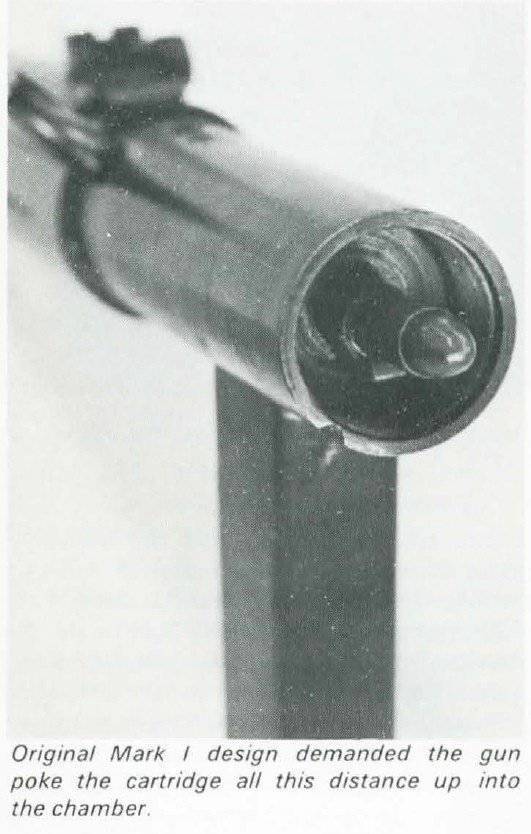
Power is supplied by cartridges from detachable box magazines with a capacity of 20 cartridges.

The magazine is inserted in a very unusual way: in the front half of a special gutter, which is wider than the magazine approximately 2 fold.
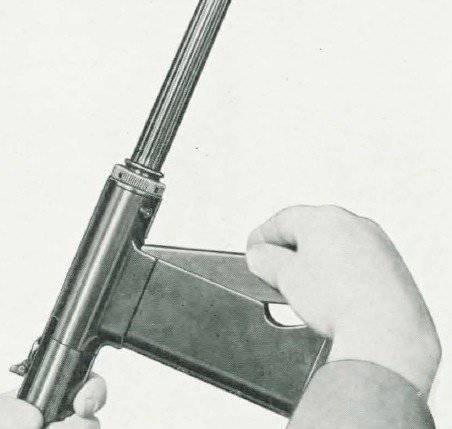
The back of the gutter (which the magazine does not occupy) is empty and open at the bottom. In other words, at the base of the gutter, behind the store - there is a hole of a rectangular cross section. Through this emptiness down (parallel to the store) there is an ejection of the spent cartridges.
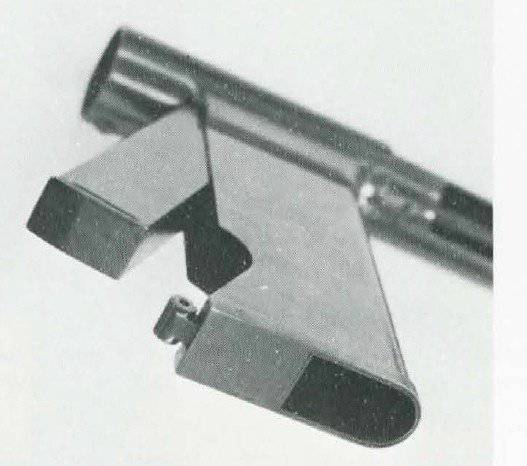
This design not only complicated and weighted the weapon, but also made it difficult to eliminate delays during firing due to the non-discharge of spent cartridges, and also made it problematic to shoot with the store's rest in the ground, the parapet or other support blocking the window for the weapon sleeves to fall out.
The latch of the store is located at the bottom of the gutter for the store, in front. The bolt handle is at the top and shifted to the right side of the weapon. Adjustable diopter sight, with adjustable aiming shooting at 50, 100, 200, 300 and 400 feet. As far as I was able to figure out, safety devices on different versions of the M1940 carbine differed both in design and in action: the Mark I was equipped with a lever type safety lock locking the sear, and the Mark II was equipped with a lever type safety device (rotator) that locked the bolt. The lever-type fuse (rotator) was quite large and performed another function: in the switched-on state (turned forward), he blocked the trigger guard and the trigger with his body.
In winter, this prevented the accidental pressing of the trigger when grabbing the trigger with a gloved hand and the accidental pressing of the trigger when placing a gloved finger in the opening of the trigger guard.
In other sources write like this:
Indeed, in the diagram in front of the trigger guard, the bolt head and a switch are visible, and to them are explanatory inscriptions: “trigger stop screw” and “trigger stop screw latch”.
Separately, words are translated as:
trigger - the trigger;
stop - stop, limiter;
screw - screw, bolt, screw;
latch - latch, latch, constipation.
How it was correctly called and how it worked - guess yourself.
“The Mark II had a different safety mechanism: the hammer was made as part of the shutter mirror, and not as a separate piece like the S&W Mark I”.
Turning this sleeve, which has an external notch, causes the slot to shift from the path of the cocking handle, thereby locking the bolt in the front or rear position. ”
In the factory version, a wooden butt was installed on the carbine, but the British equipped a part of the carbines with metal pistol handles with detachable butts, which were developed at the factory in Enfield.
There were attempts to create the S&W M1940 with an automatic firing mode (bursts), but it never got beyond experiments with several prototypes.
Stillborn
The S&W M1940 was a weapon anachronism even at the design stage: it was developed in the tradition of the 1928 Thompson PP. The weapon was expensive and difficult to manufacture.
Take, for example, the trunk: it had longitudinal ribbing along its entire length (12 ribs) and was therefore manufactured in an expensive way - by machining on a milling machine. Each edge is a separate operation on the machine, and it took a lot of time and high skill of the machine operator to make one barrel.
In any weapon, the receiver is one of the most expensive elements and to reduce the cost of production, it is made by stamping or casting, or even from seamless rectangular pipes. And the S&W M1940 has an unnecessarily complex and expensive receiver: it consists of three parts, which were forged from manganese steel. Then these parts were machined to almost zero tolerances in order to ensure a tight fit when combined to smoothly slide the shutter.
The user manual says that the carbine consists of 46 parts.
And most of them, including all sorts of small parts like studs and pins, are made by forging. And for the manufacture of any, even the smallest details, 3-4 operations were required.
The barrel and the trigger were made of chromium-nickel steel, and the shutter was made of nickel steel. In general, “do not save on materials and specialists”.
The S&W M1940 self-loading carbines were distinguished by a very high quality of exterior finish and materials. Even the belt was made of very high quality genuine leather.
And after the war, the British left the remaining M1940 carbines, despite the quality of the finish. They say that everything that was collected was cut in half and even dropped into the English Channel.
Considering the small number of carbines produced and the scanty number of surviving samples, the S&W M1940s are of great collectible value. For example, the starting price of the S&W Mk 1 carbine (serial number 423) put up for auction at icollector.com is $ 6000.
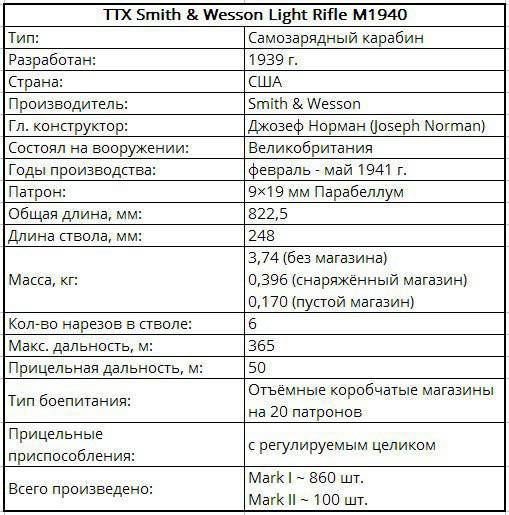
Information sources:
GunFacts February 1969
http://www.forgottenweapons.com
http://www.grantcunningham.com
http://world.guns.ru
http://www.icollector.com
http://gunsite.narod.ru
http://weapcach.ru
http://worldweapon.info
http://www.guns.com
http://forum.guns.ru
Smith & Wesson M1940 Light Rifle review
Shooting Smith & Wesson M1940 Light Rifle


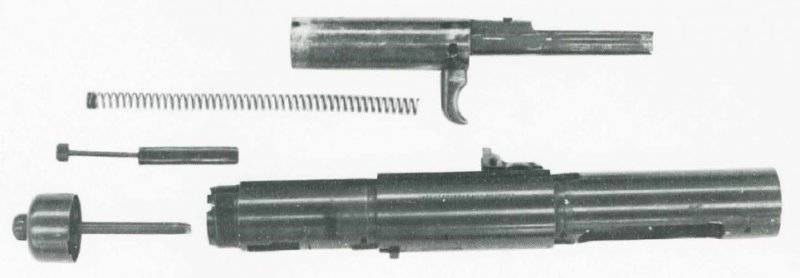
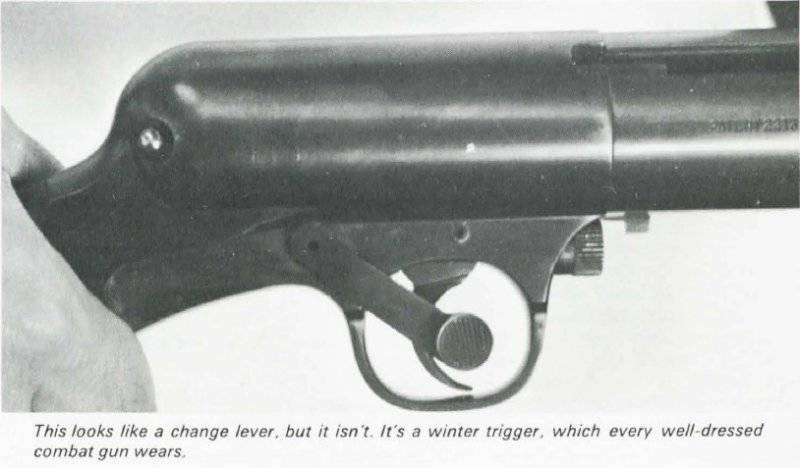
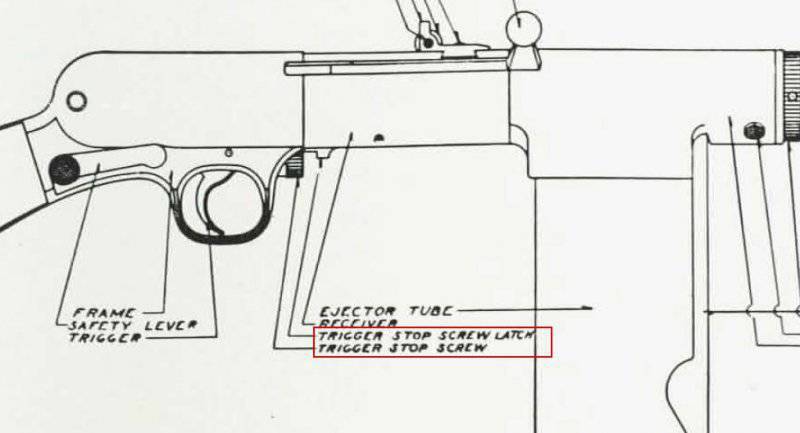

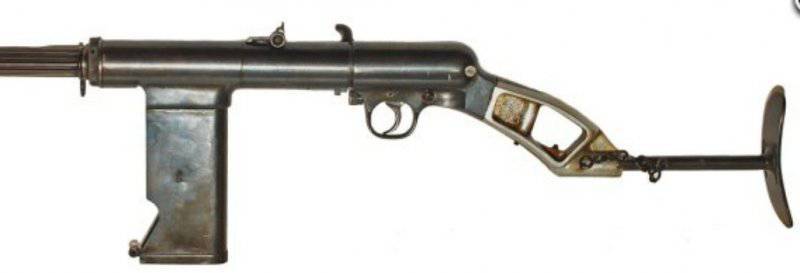
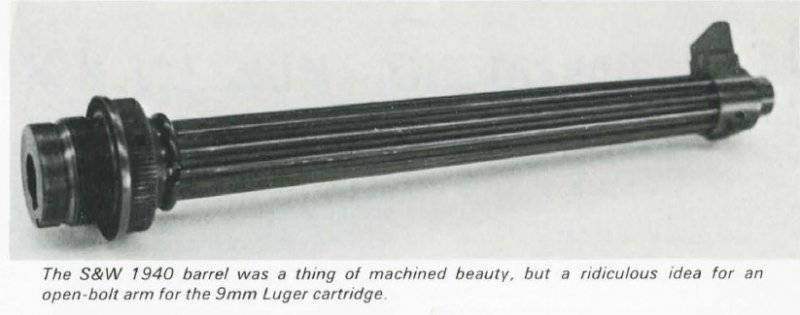
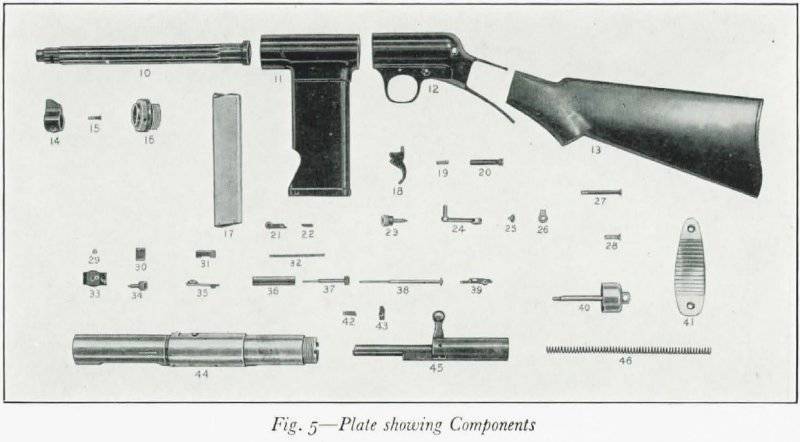
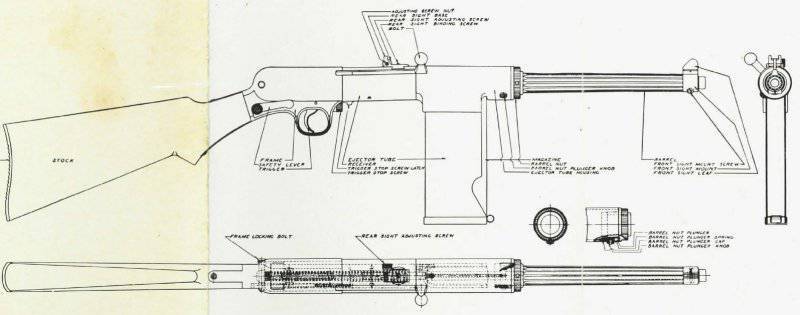

Information